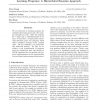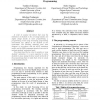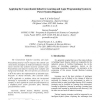2045 search results - page 42 / 409 » Learning programming with Erlang |
ICML
2010
IEEE
13 years 8 months ago
2010
IEEE
We are interested in learning programs for multiple related tasks given only a few training examples per task. Since the program for a single task is underdetermined by its data, ...
ICALT
2007
IEEE
13 years 9 months ago
2007
IEEE
In order to analyze the factors that raise the motivation of students in the art design faculty and digital design faculty to learn programming, a programming course using Process...
APIN
1999
13 years 7 months ago
1999
The Connectionist Inductive Learning and Logic Programming System, C-IL 2 P, integrates the symbolic and connectionist paradigms of Artificial Intelligence through neural networks...
ACMSE
2010
ACM
13 years 5 months ago
2010
ACM
Reinforcement Programming (RP) is a new technique for automatically generating a computer program using reinforcement learning methods. This paper describes how RP learned to gene...
VL
2010
IEEE
13 years 6 months ago
2010
IEEE
Many machine-learning algorithms learn rules of behavior from individual end users, such as taskoriented desktop organizers and handwriting recognizers. These rules form a “prog...



